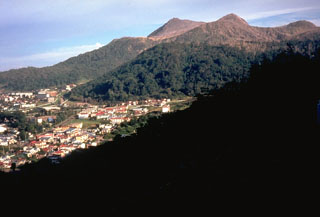Report on Toya (Japan) — December 1983
Scientific Event Alert Network Bulletin, vol. 8, no. 12 (December 1983)
Managing Editor: Lindsay McClelland.
Toya (Japan) Fumarole temperatures decline slightly
Please cite this report as:
Global Volcanism Program, 1983. Report on Toya (Japan) (McClelland, L., ed.). Scientific Event Alert Network Bulletin, 8:12. Smithsonian Institution. https://doi.org/10.5479/si.GVP.SEAN198312-285030
Toya
Japan
42.544°N, 140.839°E; summit elev. 733 m
All times are local (unless otherwise noted)
Usu's major explosions of August 1977 were followed by rapid (but decreasing) cryptodome growth and seismicity. Smaller explosions started in November 1977, became more vigorous and frequent during the following summer, and ended in October. The rate of cryptodome growth increased briefly in early 1978 but slowed gradually, as did accompanying seismicity, for the next several years, ceasing rather abruptly in early 1982. Some points on the cryptodome rose as much as 180 m and a baseline between the N foot of the volcano and its N crater rim had shortened by a similar amount by early 1982 (Yokoyama, Katsui, and Abiko, 1983).
The following is a report from S.N. Williams. "A team of U.S. and Japanese scientists visited Usu's crater in mid-August to continue their study of fumarole mineral geochemistry and mineralogy begun in September 1981. Fumarole locations, distribution of fumarole incrustations, and temperatures were mapped. Samples of gas and fumarole sublimates were collected.
"Peak fumarole temperatures have declined somewhat. Fumarole 2, 770°C in 1981, was 730°C in 1983; no. 3 decreased from 690 to 650°C; no. 1 from 550 to 545°C. Gas discharge continued at a tremendous rate with the associated roaring jet sound. Extensive deposition of fumarole incrustations continued. All of these fumaroles were located in a narrow valley between the 1977-82 cryptodome (Usu-Shinzan) and Ko-Usu, a lava dome extruded in either the 1663 or 1769 eruption.
"Overall, a broad concentric zonation was noted in the temperature distribution of the fumaroles. Large areas of steaming ground on Ko-Usu dome and Usu-Shinzan formed an aureole around the high-temperature fumaroles. These approximately 100°C fumaroles continued to emit large quantities of H2S. Gin-numa Lake appeared to maintain about the same level as in 1981."
Reference. Yokoyama, I., Katsui, Y., and Abiko, T., 1983, The 1979-1982 Activities of Usu Volcano in Report on Volcanic Activities and Volcanological Studies in Japan for the Period from 1979 to 1982; Bulletin of the Volcanological Society of Japan, v. 28, no. 1, appendix, p. 15-19.
Geological Summary. Usuzan, one of Hokkaido's most well-known volcanoes, is a small stratovolcano located astride the southern topographic rim of the 110,000-year-old Toya caldera. The center of the 10-km-wide, lake-filled caldera contains Nakajima, a group of forested Pleistocene andesitic lava domes. The summit of the basaltic-to-andesitic edifice of Usu is cut by a somma formed about 20-30,000 years ago when collapse of the volcano produced a debris avalanche that reached the sea. Dacitic domes erupted along two NW-SE-trending lines fill and flank the summit caldera. Three of these domes, O-Usu, Ko-Usu and Showashinzan, along with seven crypto-domes, were erupted during historical time. The 1663 eruption of Usu was one of the largest in Hokkaido during historical time. The war-time growth of Showashinzan from 1943-45 was painstakingly documented by the local postmaster, who created the first detailed record of growth of a lava dome.
Information Contacts: S. Williams, R. Stoiber, and J. Patterson, Dartmouth College; T. Abiko, Muroran Inst. of Tech.

